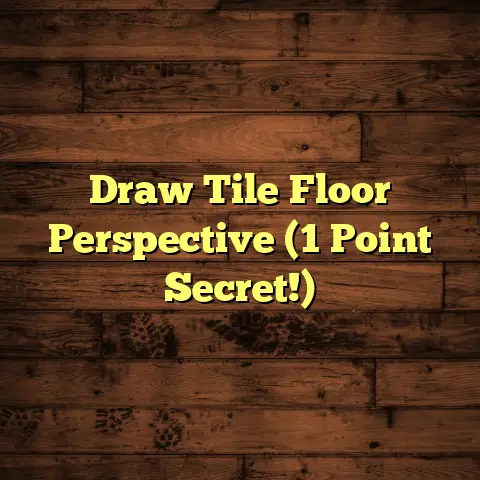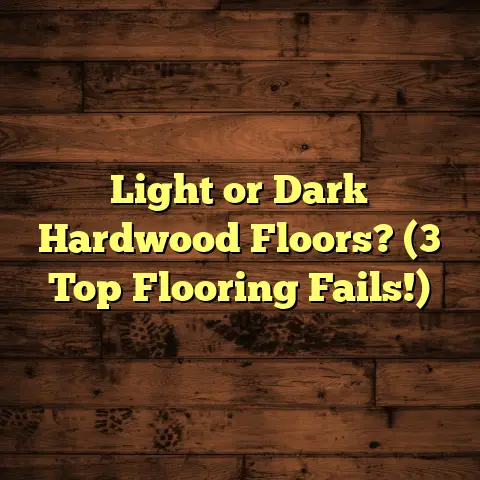White Oak Vs Red Oak Flooring Cost (Explained)
When considering hardwood flooring for your home or commercial space, one of the critical decisions involves choosing between different types of wood.
White oak and red oak are two popular choices, each with unique characteristics, aesthetics, and costs.
This article provides a comprehensive overview of the cost factors associated with installing these types of flooring, along with comparisons to alternative flooring options, maintenance tips, and other essential considerations.
Overview of Major Cost Factors
Area Size
The size of the area where you plan to install flooring is the most significant cost factor.
Flooring is typically priced per square foot, so larger areas will naturally incur higher costs.
Hardwood Type
The choice between white oak and red oak significantly impacts pricing.
Each type has its own market demand and price point based on availability and aesthetic appeal.
Labor Costs
Labor costs vary by region and the complexity of the installation.
Hiring a professional installer generally increases overall costs but ensures a higher quality finish.
Additional Considerations
- Floor Removal: If you need to remove existing flooring, this will add to your total cost.
- Subfloor Replacement: Replacing or repairing a subfloor adds additional expenses that should be factored into your budget.
- Material Grade: The grade of wood (select, #1 common, #2 common) affects pricing, with higher grades costing more.
- Room Size/Layout: Complex layouts may require more cutting and fitting, increasing labor costs.
- Installation Type: The method of installation (nail down, glue down, floating) influences both labor and material costs.
Cost Breakdown for White Oak vs. Red Oak
White Oak Costs
- Material Costs: $4 to $8 per square foot
- Total Installation Costs: $8 to $14 per square foot (including materials and labor)
Red Oak Costs
- Material Costs: $3 to $7 per square foot
- Total Installation Costs: $7 to $13 per square foot (including materials and labor)
Summary of Cost Differences
While both white oak and red oak are relatively comparable in cost, white oak tends to be slightly more expensive due to its durability and appeal.
Comparison with Alternative Flooring Options
Laminate Flooring
- Cost: $1 to $5 per square foot
- Pros: Affordable, easy to install, wide variety of designs.
- Cons: Less durable than hardwood, cannot be refinished.
Vinyl Flooring
- Cost: $2 to $7 per square foot
- Pros: Water-resistant, comfortable underfoot, low maintenance.
- Cons: Not as aesthetically pleasing as hardwood.
Carpet
- Cost: $2 to $5 per square foot
- Pros: Soft underfoot, available in various styles.
- Cons: Can stain easily, requires regular cleaning.
Signs That Hardwood Floors Need Replacement
- Deep Scratches and Gouges: If refinishing can’t restore the floor’s appearance.
- Warping or Cupping: Caused by moisture damage.
- Severe Discoloration: Indicating wear beyond refinishing.
- Multiple Repairs: If you find yourself frequently fixing issues.
Pros and Cons of Hardwood Flooring
Pros
- Aesthetics: Timeless beauty that enhances home value.
- Durability: Can last decades with proper care.
- Refinishing Potential: Can be sanded and refinished multiple times.
Cons
- Cost: Higher initial investment compared to alternatives.
- Susceptibility to Moisture: Requires careful maintenance in wet areas.
- Noise: Can be louder than carpeted floors.
Professional Installation vs. DIY
Professional Installation
- Cost: Typically adds $3 to $7 per square foot in labor.
- Benefits: Expertise ensures proper installation and longevity.
DIY Installation
- Cost Savings: Eliminates labor costs but requires an investment in tools and time.
- Considerations: Requires knowledge of installation techniques; mistakes can lead to costly issues.
Essential Tools for DIY Installation
- Miter saw
- Table saw
- Nail gun or flooring stapler
- Measuring tape
Questions to Ask Hardwood Flooring Contractors
- What is included in your estimate?
- What type of wood do you recommend for my project?
- How much experience do you have with hardwood installations?
- Can you provide references from previous clients?
- What is your proposed timeline for completion?
Hardwood Floor Care and Maintenance Tips
- Regular Cleaning: Sweep or vacuum frequently to remove dirt and debris.
- Use Rugs: Place rugs at entry points to reduce wear.
- Avoid Excessive Water: Wipe spills immediately and avoid mopping with excess water.
- Refinish as Needed: Depending on wear, plan to refinish every 5 to 10 years.
- Control Humidity Levels: Maintain consistent humidity levels to prevent warping.
Conclusion
Choosing between white oak and red oak flooring involves considering both aesthetic preferences and budgetary constraints.
Understanding the cost factors associated with installation—such as material prices, labor costs, and additional project considerations—will help you make an informed decision that fits your needs and lifestyle.
Whether you opt for professional installation or take on a DIY project, proper planning and maintenance will ensure that your hardwood floors remain beautiful and functional for many years to come.




